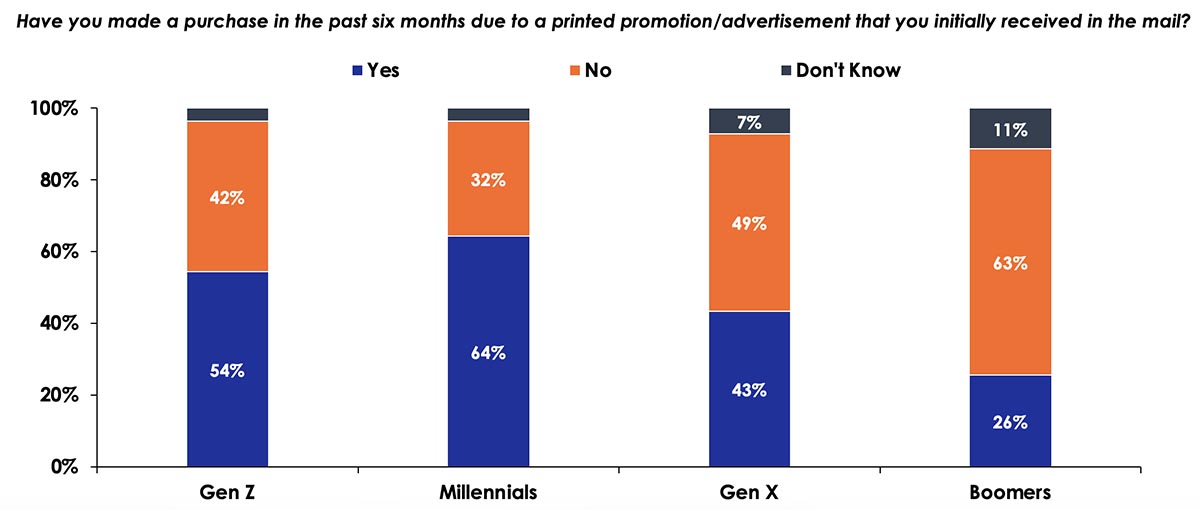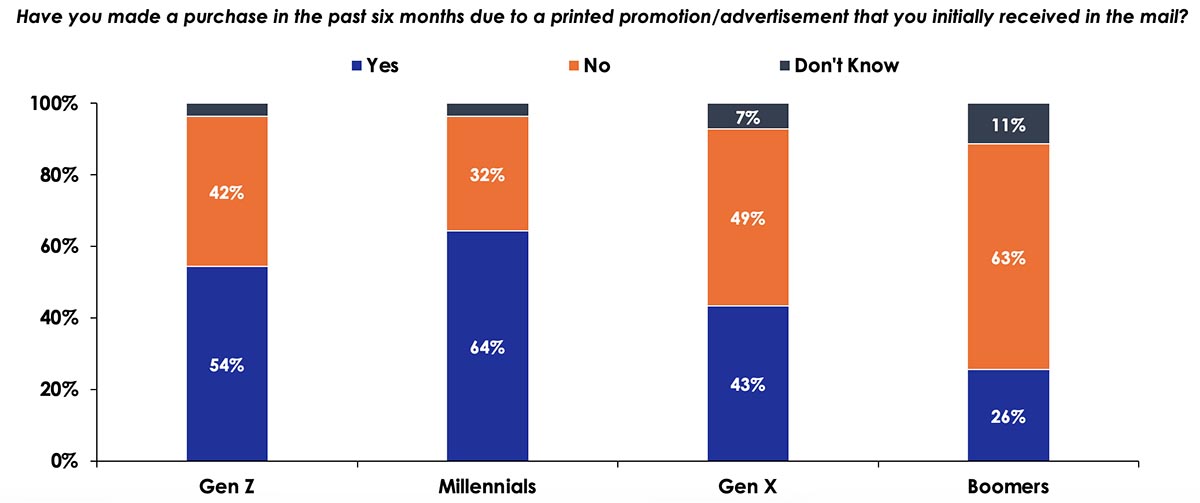- Keypoint Intelligence’s research reveals that consumers of all ages—even Gen Zers and Millennials—are reportedly more likely to engage with a printed piece than a digital communication.
- Over half of the younger demographics reported making purchased based on direct mail in the past six months.
- One of print’s most compelling qualities is that it plays well with digital channels. Printed communications with digital components can be quite effective in reaching younger consumers.
By Eve Padula
Introduction
There’s no question that the communications landscape is changing. Today’s brands have more ways than ever to connect with and engage their intended audiences. Meanwhile, consumers also have an array of options for staying in touch with their favorite brands. To better understand how consumers of various ages engage with printed communications, Keypoint Intelligence analyzed its recent Annual State of Transactional Communications research with a focus on commonly identified generations (i.e., Generation Z, Millennials, Generation X, Baby Boomers). This research confirms that consumers—even younger ones—still see the value of printed communications. In fact, print may be uniquely positioned to cut through the digital clutter and prompt so-called digital natives to engage and take action. This article explores how generational differences can affect consumers’ preferences when interacting with printed communications.
The Adult Generations
For the purposes of this study, the specific generational breakouts were identified as follows:
- Generation Z: Born between 2004 and 1997; 18–25 years old as of 2022.
- Millennials: Born between 1981 and 1996; 26–41 years old as of 2022.
- Generation X: Born between 1965 and 1980; 42–57 years old as of 2022.
- Baby Boomers: Born between 1948 and 1964; 58–74 years old as of 2022.
Because this survey was only open to adult consumers between the ages of 18 and 74, it should be noted that the youngest members of Generation Z (born between 2005 and 2012 and 10–17 years old in 2022) and the oldest Baby Boomers (born in 1946 or 1947 and 75 or 76 years old in 2022) were not within range for participation in our study.
Printed Communications Prompt Engagement
Perhaps the most compelling evidence that consumers of all ages recognize the benefits of print came when respondents were asked about their likelihood of engaging with printed or digital communications. Younger consumers were more likely to engage with digital communications than their older counterparts (44% of Gen Z vs. 31% for Boomers), but this is hardly a surprise. What is surprising is that the share of consumers who were more likely to engage with a piece of physical direct mail exceeded the share that would engage with digital across ALL age brackets. To put this another way, even Gen Zers and Millennials were reportedly more likely to engage with a printed piece than a digital communication.
Figure 1. Likelihood of Engaging with Print or Digital (By Age)

N = 1,500 Total Consumer Respondents
Source: Annual State of Transactional Communications Consumer Survey; Keypoint Intelligence 2022
When total respondents were asked if they had recently made a purchase that was triggered by a direct mail piece, over half of Gen Zers and Millennials answered affirmatively. As shown in the Figure below, direct mail was especially likely to influence purchases among Millennials. In general, though, younger consumers are making purchases because of direct mail. Older respondents make purchases based on direct mail too, but tried-and-true print seems particularly likely to prompt younger consumers to open their wallets.
Figure 2. Purchases Based on Direct Mail (By Age)

N = 1,500 Total Consumer Respondents
Source: Annual State of Transactional Communications Consumer Survey; Keypoint Intelligence 2022
Most consumers are inundated with e-mail and text messages, and the younger generations can barely—if at all—remember a time when digital communications weren’t a part of their lives. It could be that direct mail is more of a novelty to younger consumers, who have become quite skilled at filtering through all the digital noise they encounter on a daily basis. Printed communications are less numerous, and they also have a tangible presence that makes them more difficult to ignore.
One of print’s most compelling qualities is that it plays well with digital channels. Printed communications can include a link to a digital channel, such as a link to a website or a QR code that can be scanned with a mobile device. Ultimately, direct mail offers another way for brand owners to engage their customers—and it appears that younger consumers are getting the message!
The Bottom Line
Printed communications continue to play a vital role in today’s world. The reality is that consumers—even younger ones—still recognize the value of print. All of this being said, today’s consumers can’t be put into a box. Age-based behaviors can certainly serve as a rough guideline, but service providers must learn and acknowledge their customers’ unique preferences regardless of age. In the end, an experience that is customized to the intended recipient is one of the best ways to foster loyalty and encourage engagement.
Eve Padula is a Senior Consulting Editor for Keypoint Intelligence’s Production Services with a focus on Business Development Strategies, Customer Communications, and Wide Format. She is responsible for creating many types of content, including forecasts, industry analyses, and research/multi-client studies. She also manages the writing, editing, and distribution cycles for many types of deliverables.










Discussion
Join the discussion Sign In or Become a Member, doing so is simple and free